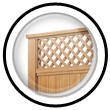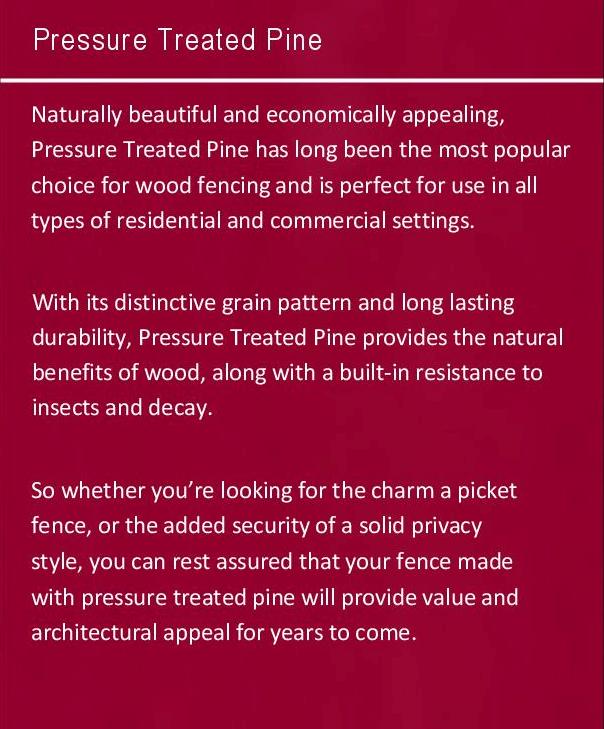Treated Wood Fence Materials

You can Move around the woods here
- Wood Privacy Fence System
- Wood Picket Fence System
- Wood Post and Rail Fence System
- Wood Custom And Lattice Fence System
- How to protect your fence
- The war! of the woods ♪♪what is it good for??♪♪
- Wood gate hardware
Cedar Fence | Pressure-treated Pine Fence |

Pressure Treated Pine Fence Materials
Pressure Treated Pine Fence Materials Cedar Fence Materials Advantages of a Wood Fence
Wood fences are the classic fence for residential and commercial applications and are seen in many neighborhoods across Georgia. The advantages of installing a wood fence are:
Cost-effective
Light and easy to install or remove Can be painted almost any color paint
The shape and size are versatile Biodegradable and environmentally friendly
Wood fences come in the greatest variety of styles and looks. This gives you the greatest number of choices. Without proper care, they will degrade and need to be replaced
- What’s pressure-treated wood?
- What are some of the advantages of pressure-treated wood?
- What kind of treated wood is available?
- What guarantee does treated wood have?
- What about any cracking, warping, and graying that may show up over time?
- What can be done to eliminate the effects of weathering and keep that “new fence” look?
It’s wood that has been pressure-impregnated with an effective preservative. This treatment helps wood resist attacks by termites and decay-causing fungi.
It’s economical; works easily with common tools; is naturally attractive; durable; strong for its weight; and is readily available in a wide variety of sizes and styles.
You can choose from different grades of treated wood to match your goals for strength and appearance. Treatment does not affect the lumber grade; it simply makes the wood last longer. For this reason, domestic and import Pine is a popular choice. With pine we can specify the proper grade and it readily accepts treatment. We can provide all the post, rails, and fence boards needed to “stick-build” an entire fence, plus pre-assembled panels.
No guarantee is offered. However, we provide a warranty against damage caused by termites and fungal decay.
What about any cracking, warping, and graying that may show up over time?
Even though pressure-treated wood is protected from termites and fungal decay, it is still a porous, natural material. Wood swells when it absorbs moisture and shrinks when it dries out. The drying process creates stresses in the wood, which contributes to cracking and warping. The sun’s ultra-violet (UV) rays cause the wood to turn gray. Pressure-treated wood is subject to these effects, just like other lumber.
What can be done to eliminate the effects of weathering and keep that “new fence” look?
While there’s no way to eliminate the weathering of wood, it’s relatively easy to minimize the effects
- Use three back rails (6′ fence), two backrails (4′, 5′ fence), or 4 backrails (8′ fence) for more hold-down points.
- Use only hot-dipped galvanized, or stainless steel fasteners with a ring or spiral shank to minimize warp and rust stains.
- Treat the surfaces of fence boards with a water-repellant solution to reduce the rate that moisture is absorbed and released. This solution should also have a good UV inhibitor if you don’t want the fence to gray.
- Follow a regular maintenance program of cleaning and refinishing every few years with a “clear” or “toner” water repellant containing UV inhibitors. This will revitalize a dingy appearance caused by dirt, mildew or graying. It’s like washing and waxing your car. Opinions differ on how necessary it is to perform regular maintenance, but most agree your fence will look much better for the effort.
One thing to note about using pressure-treated pine materials with the installation of fences
For years, the treated-lumber industry got a deservedly bad rap for preservatives that included toxic chromate copper arsenic (CCA). In 2003 the industry voluntarily suspended the use of CCA for residential use, although it continues to be used for commercial applications. Today’s treated-wood preservatives still include some form of copper, which isn’t toxic and inhibits the growth of mold and mildew, and repels insects. Some manufacturers avoid the telltale incisions used to help preservative chemicals penetrate the wood. Instead, they employ new high-pressure techniques that drive the preservatives deep into the heart of the lumber. Another trick: Adding water repellants to the preservatives to help the lumber fend off moisture. No matter what pressure-treated lumber you decide to use, always wear a dust mask and eye protection when cutting pressure-treated wood, and wear gloves when handling the material